Flying
EGN-1 Flight Testing
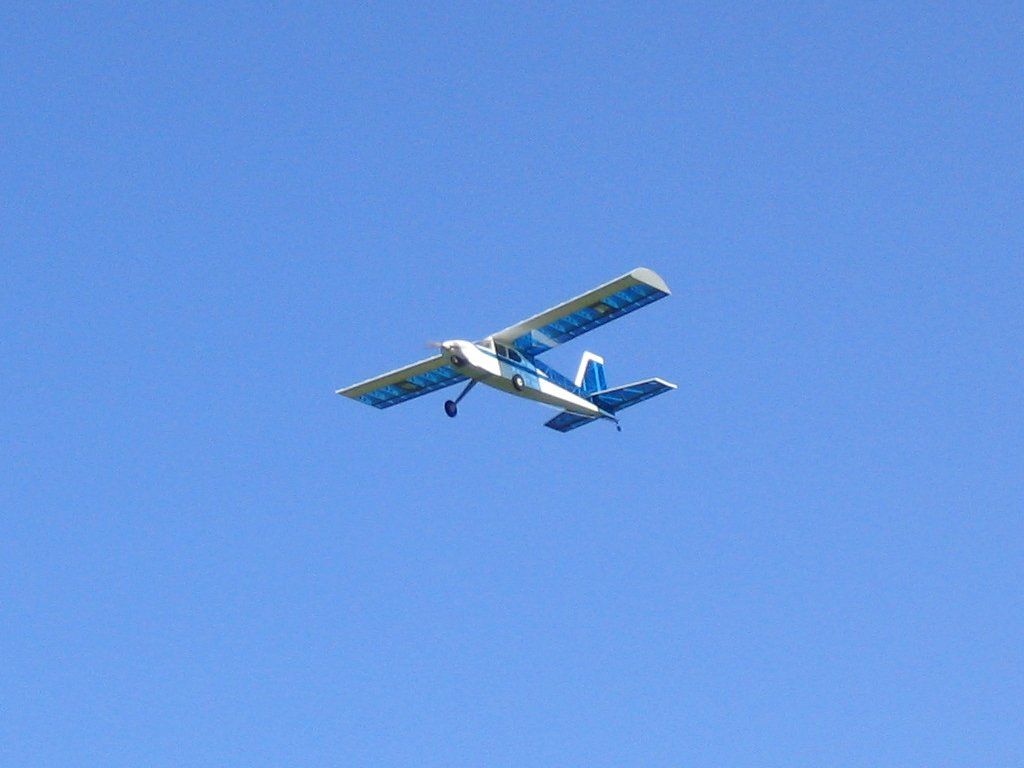
img_2634
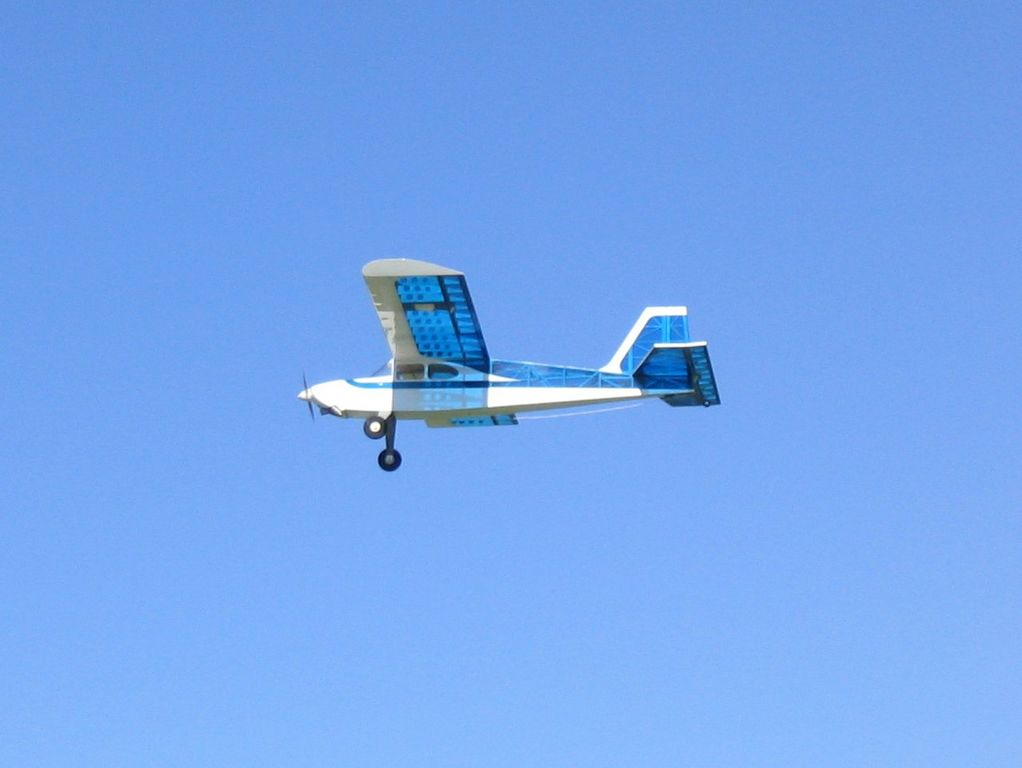
img_2635
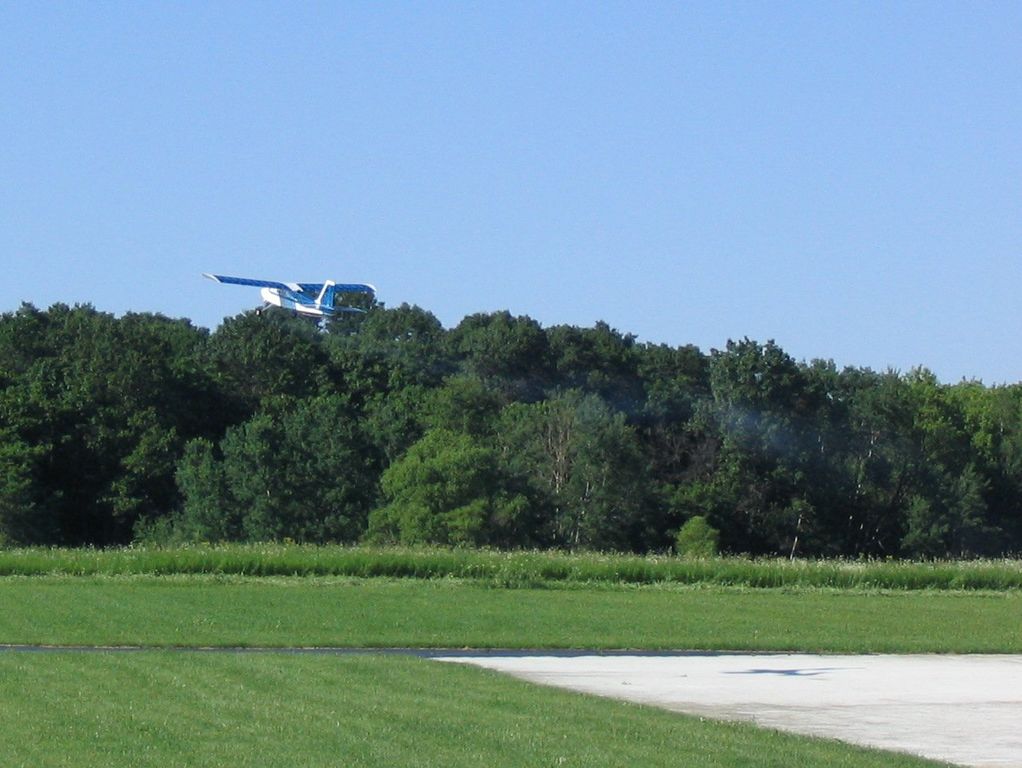
img_2637 Ahhh, green grass, blue skies, fair winds, and an R/C airplane …
May 21, 2008.
This winter I ripped out the old 4 stroke engine that was broke. That engine has been repaired, but I decided not to put it back in. Instead I decided that this light “stick built” airframe is crying to be electric powered. I bought an E-Flight 46 motor over the winter and installed it. Then when the bank balance rebounded a bit I bought a Castle Creations Phoenix 60 speed controller. Finally, yesterday, I scratched my head and worked out battery placement and installation. I have 2 x 8000 mAh 18.5v lipoly batteries from the telemaster project, and one of these seems to balance out the airframe perfectly when it is as far forward as I can put it.
Today I ran out to the field during my lunch break to try it out. I kept the original wood 12×6 prop I ran with the 4 stroke motor. No particular reason other than I like wood and nylon razor blades make me nervous.
Ok, so can you say way over powered? This combination will cruise nicely at just a few notches of throttle, and things start getting a little crazy above half throttle. Today was a really gusty swirly day, so I kept things slow and gentle and just tooled around the way a trainer should be flown. Plus I want to secure the big 2 lb battery just a little better before I start pulling too many g’s with it.
Two repair notes: (1) The tail wheel servo was partially stripped out when I got to the field today. That must have happened last year and went unnoticed. It really only affected how sharp I could steer to the left on the ground so I flew with it like that and didn’t worry too much about it. When I got home I dug out a replacement servo I had on the shelf and slapped it in. (2) When disconneting the deans connector after landing, I pulled a wire off. I can only blame myself for a bad solder joint, but it’s easy enough to solder up another bad joint and get flying again. 😉
It’s good to be out flying on a nice day, even if the winds are a bit gusty and swirly. After my flight, I sat and watched a dust devil blow across our field sucking up stuff and sending it at least 1000′ skyward … pretty cool but I guess I’m glad i didn’t try to fly through it with the Kadet Senior!
July 28, 2007.
I haven’t gotten EGN-1 out yet this year … too busy with other projects, so I loaded it the van and was going to get it running again today. I started up the engine and didn’t like the way it sounded, so I did a run up test and it died on me. From that point on I couldn’t get it running. I popped off the cowl and observed that it was spitting fuel out the carb as if it was running backwards or had really screwed up timing. After fiddling some more I dropped the valve cover and found that one of the valve adjuster screws along with the end of the adjustment rod and broke off and was floating around up there. It was all ground up and a mess. 🙁 So I think I need to write off this engine and find a replacement. It’s always something, but I’d rather discover these sorts of problems on the ground rather than in the air or just short of clearing the corn at the end of the runway. 🙂
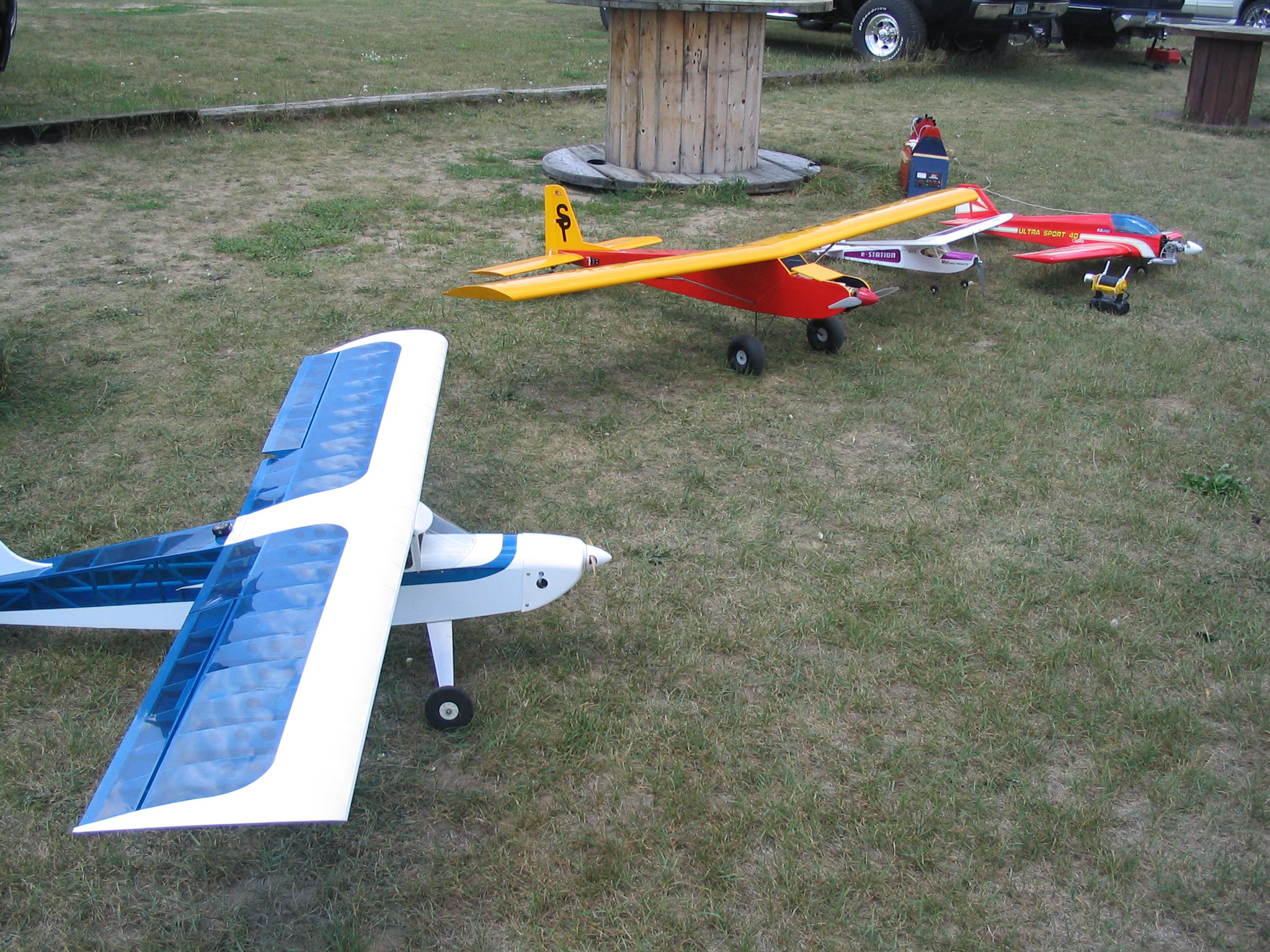
IMG_4698
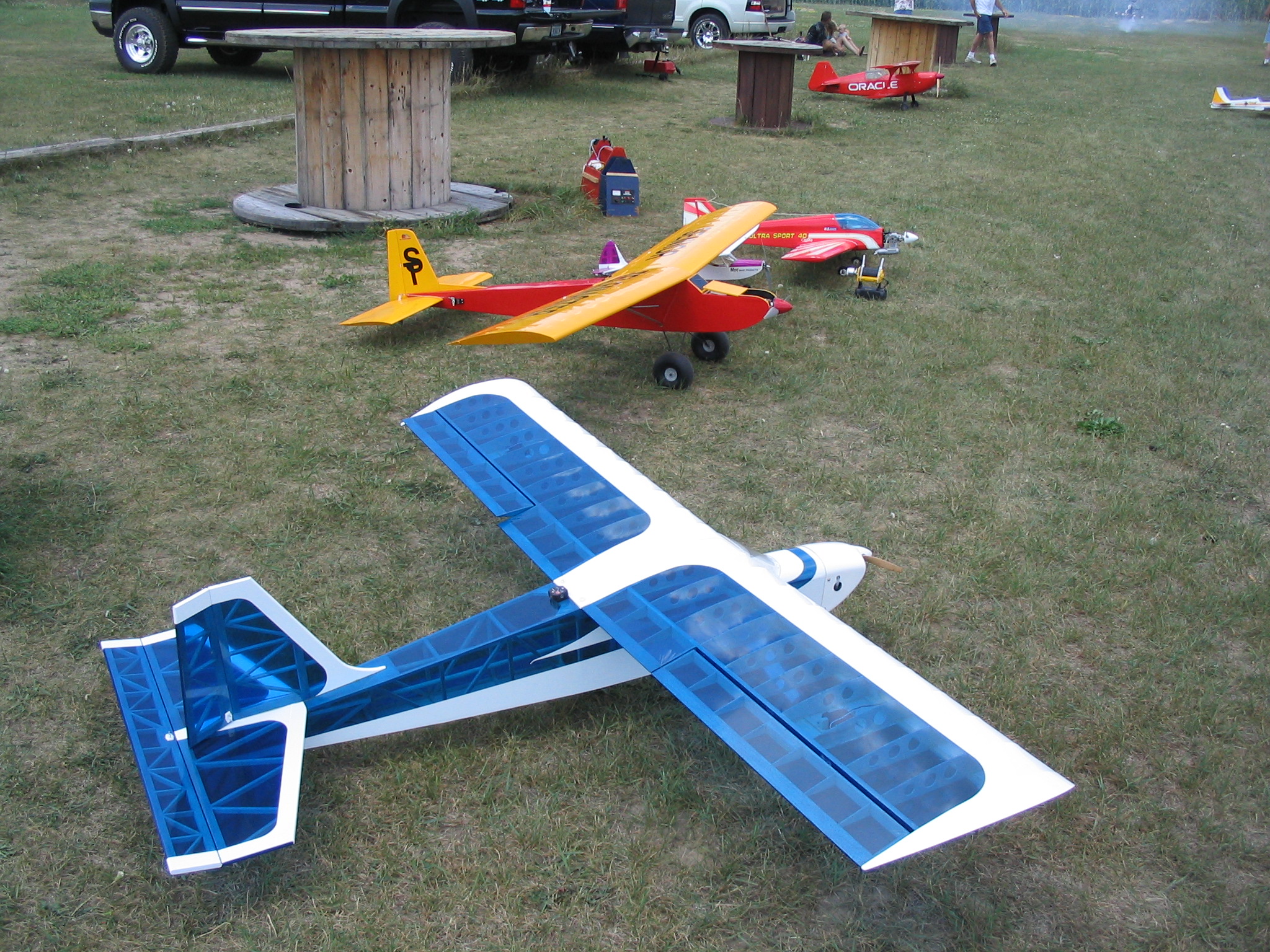
IMG_4699

IMG_4700

IMG_4701
May 20, 2006.
Conditions: Winds out of the E and light to start out with, switching more to the NNE and picking up to 10-15 mph by late afternoon. We had light showers come through in mid-day. Temps a bit tool cool for the shorts and t-shirt I decided to wear.
I made several flights. The one item of note is that I pulled the quick fueler off and piped the fuel direct. This had a *huge* affect and the engine suddenly became *way* rich to the point of not running. I had to go at least two turns in to get the engine running again. I think this was my last quick fuel valve I’ll ever use. It seems like a good idea, but I’ve had no end to fuel flow problems, unreliable engines that are impossible to tune across their whole rpm range. Hopefully I’m on a much better track now.
I also figured out that I can push the nose down on approach to lose altitude if I’m too high. In the past I’ve just let it float, but with such a high drag wing you can dive press down on the nose in your base and final legs and you don’t pick up a ton of speed. That which you do pick up quickly bleeds off. One of those “doh!” moments. Landings in the Sr. have now become much easier to spot and I have a lot less trouble floating by at 10′ agl.
April 10, 2006.
Objective: Demo/Play
Conditions: Temps in the 70’s, winds out of the SSE at about 10mph. Sunny!
Results: We had several good flights and one dead stick from adjusting the idle a bit too low. Here are some pictures:

IMG_0131

IMG_0132

IMG_0133
Novermber 26, 2005.
Objective: Winter flying.
Conditions: Temperature +18F, Wind chill +5F. Winds out of the ESE at 5-10 mph. Partly to mostly cloudy. About 1 inch of snow on the ground.
Results: I flew manually today with the co-pilot off; nothing other than a standard R/C airplane.
In the cold dense air, the Kadet had very nice performance. So nice in fact that I was unable to land with the engine running. Any amount of engine, no matter how slow was enough to keep the airplane puttering along with virtually no decent rate. I had to kill the engine in flight and dead stick it in for all my flights today. That worked fine, but this plane might need an extra lb. or two for ballast on these cold days!
Other than that there really wasn’t all that much to report. I dressed warm, the wheels handled the shallow snow just fine, the 90-degree cross wind didn’t seem to cause any problems. Just a very enjoyable day at the field. Oh, I did notice a significantly higher fuel burn in the cold weather which I guess makes sense. The denser air needs more fuel to maintain a proper ratio … (?)
September 10, 2005.
Objective: High wind handling tests.
Conditions: Temps in the high 80’s. Winds straight out of the south at 15-20, gusting to 25+.
Results: First off I cheated most of the time and flew with the FMA co-pilot enabled. This allowed me to worry more about ground tracking and less about keeping the wings level in the swirling gusting conditions.
Overall I had pretty good results. I actually had to tie up the plane when it was on the ground so it wouldn’t blow away. The biggest challenge I faced was getting the aircraft from the starting area to the runway. The winds were too strong to taxi (often they were higher than flight speed.) Even carrying the plane was tricky if you caught the wind wrong.
However, despite the challenging ground logistics the plane handles great in the air. I was fortunate that the wind was pretty much aligned with the runway so I didn’t have to deal with cross wind issues. The plane’s approach was very slow and at the higher wind speeds I needed to run up the throttle to 30-40% and push the nose down just to make headway towards the runway and not gain altitude. (The Kadet will climb with about 4 notches of throttle.) Once over the runway I was able to chop the throttle and land with virtually no forward ground speed.
Summary: In the hands of a moderately experienced flyer, the Kadet Senior can handle pretty fierce winds with little trouble. I wouldn’t recommend operating in a 20 mph cross wind, but a 20mph head wind is perfectly doable. If the wind grows beyond 20mph you need to be extra careful. The Kadet is so slow that I found that you will need substantial throttle just to make a small amount of headway into the wind. If you happen to lose your engine downwind in those sort of conditions, you are going to land even further down wind.
August 24, 2005.
Objective: I haven’t made much forward progress in hobby-uav land so I figured I’d take EGN-1 (in it’s current state) out for a few flights just for fun, and to make sure everything still worked fine.
Conditions: Temps in the low-to-mid 70’s. Winds were on the heavy side, 10-15 mph gusting to 20 and blowing in from the SE.
Results: The conditions forced cross wind take offs and landings which are always fun. For most of my activities I just turned on the co-pilot and let it do it’s best to keep the wings level in the gusts. It does a pretty good job as a wing leveler and allows me to pay more attention to my ground track and crab angle and decent path. I had a couple nice landings where I was crabbing 30 degrees into the wind as I approached and touched down.
The wind was blowing hard enough where I could emulate a kite. I turned on the wing leveler and trimmed it out so that it flew nearly motionless for several minutes. A click or two of elevator trim would control my forward back speed, and a notch or two of throttle would control my up/down. With very slight adjustments I was able to hold it close to motionless indefinitely. The winds were much lighter near the ground so I wasn’t able to do any kind of verticle take offs or landings.
I scuffed up a wing tip very slightly in one of the cross wind landings, but I suspect a little windex will make that all but go away.
June 16, 2005.
Objective: Accumulate flight time with and without the Co-Pilot.
Conditions: Near perfect. Temps in the middle 70’s, winds light and variable but mostly out of the north when there was any, zero clouds.
Results: I had several good flights, touch and goes, some aerobatics, and some nice relaxing meandering around the pattern. Here is a slow pass sequence …

img_2632

img_2634

img_2635 Take off. Can you spot the aircraft shadow? Notice the exhaust smoke …

img_2637 Another slow pass sequence. Turn to final, closer, closer, and then flying past …
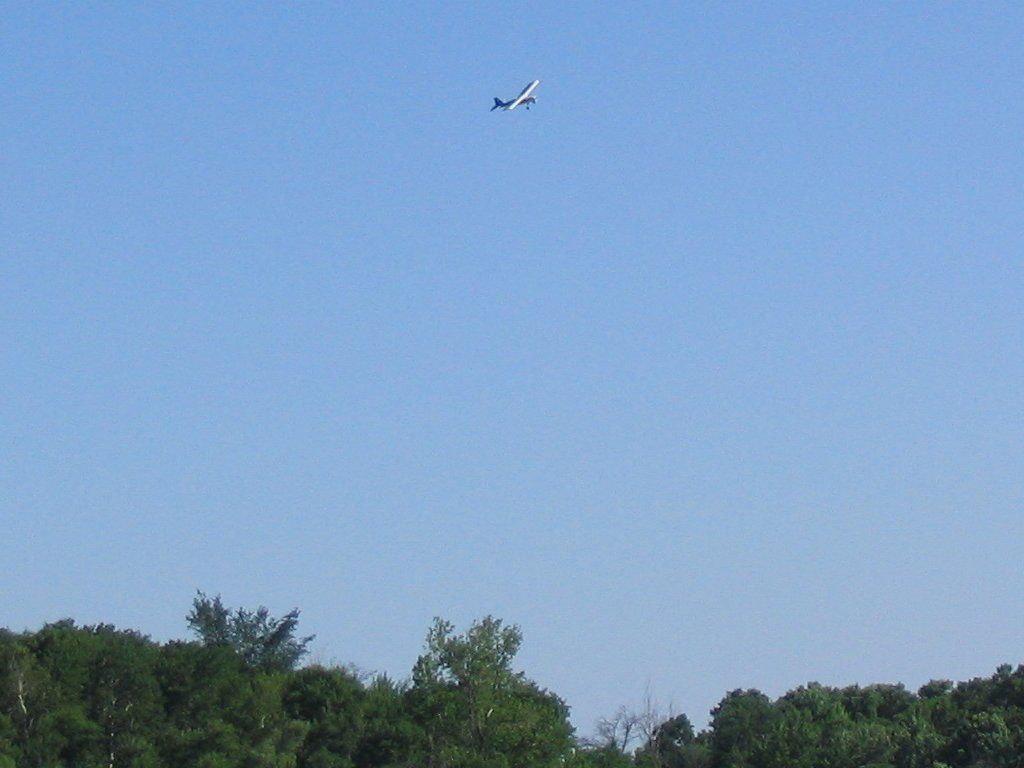
img_2645
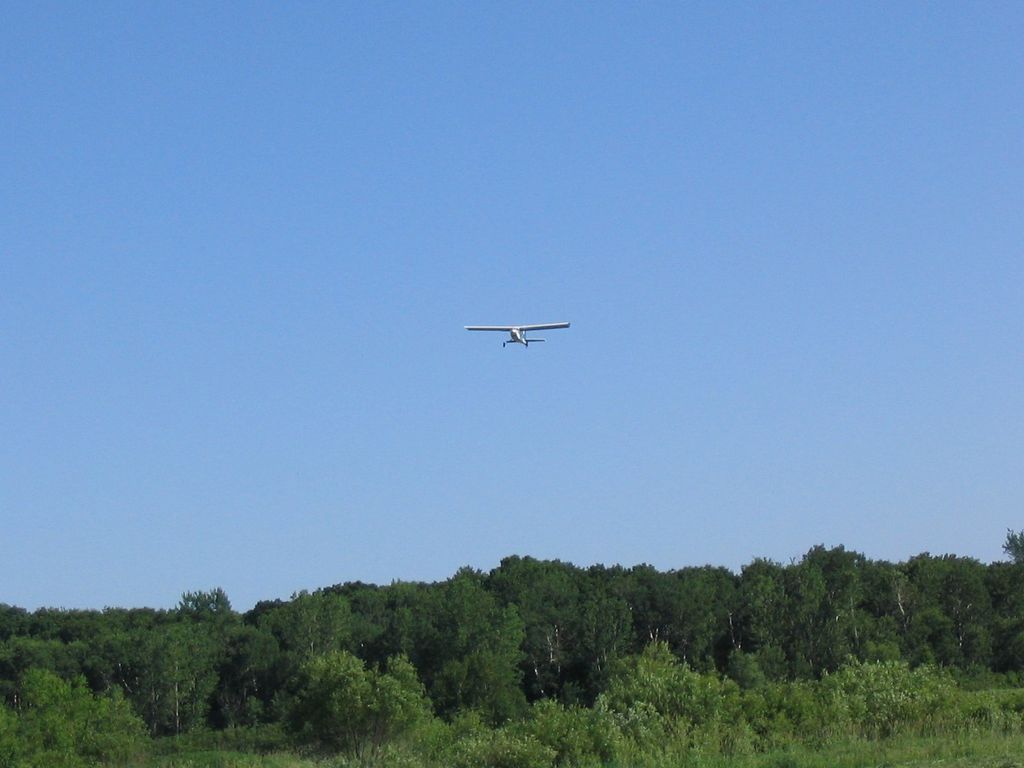
img_2646

img_2647
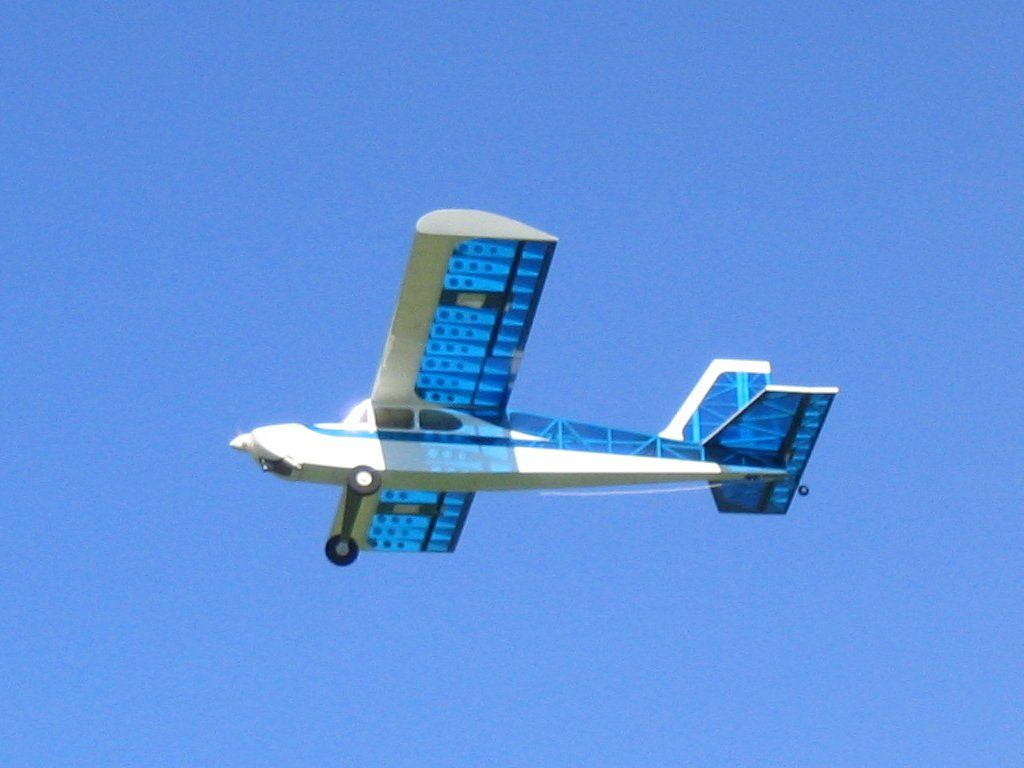
img_2649 Short final …
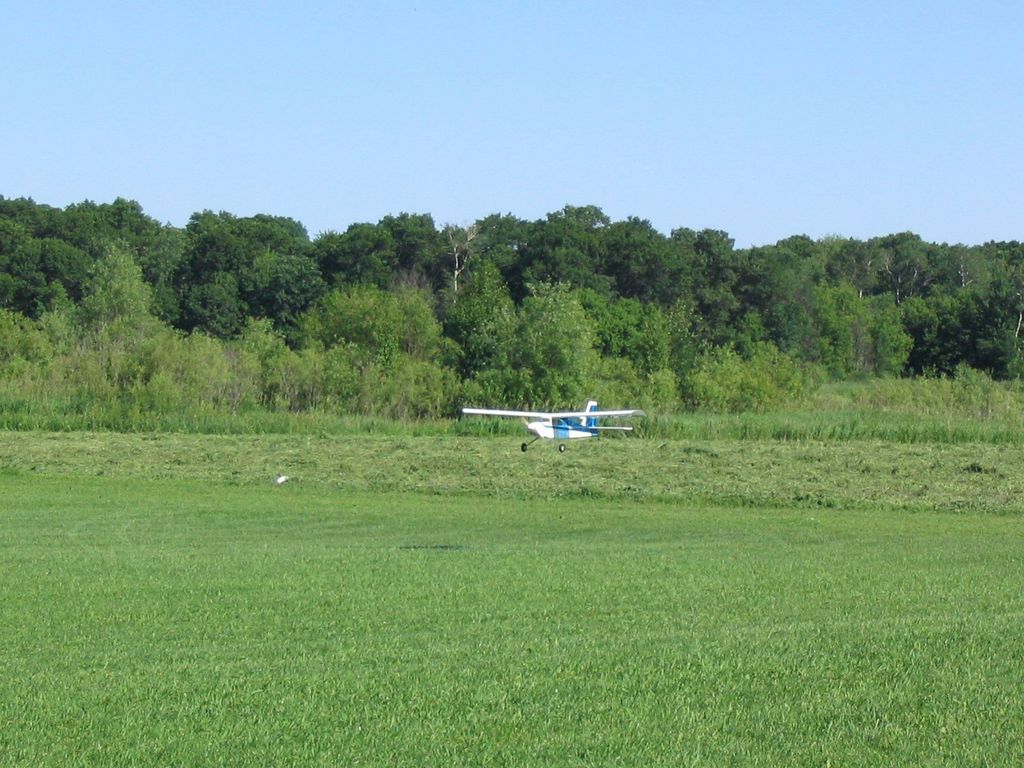
img_2652 The grass is short so I tried a grass take off …
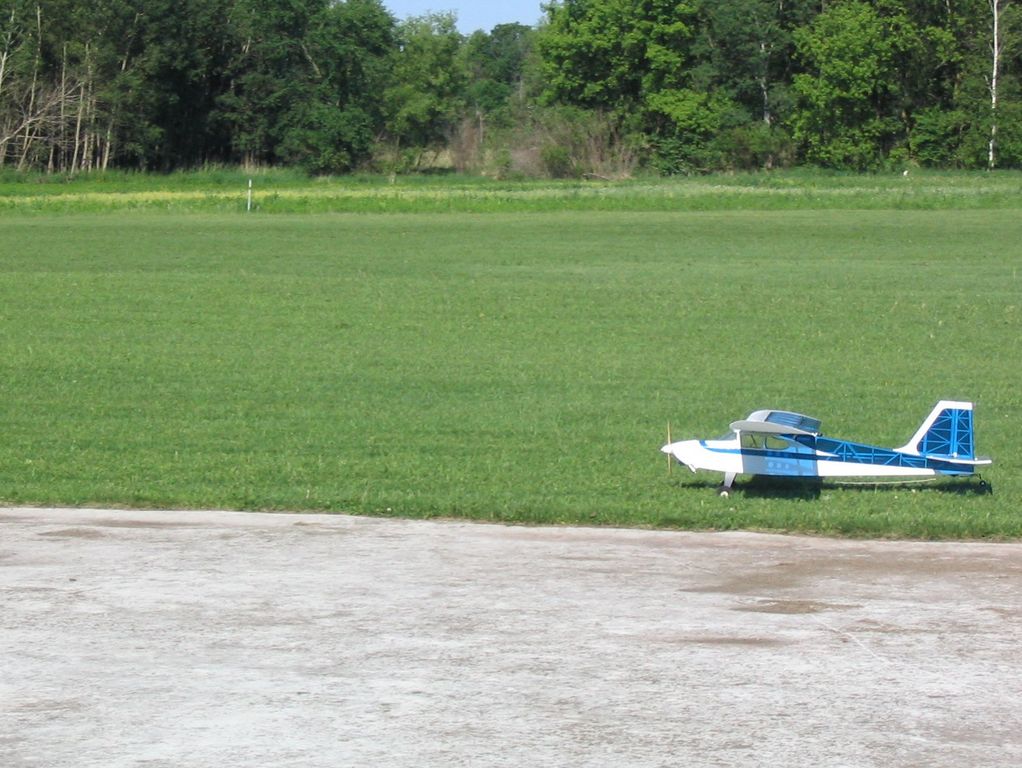
img_2654 Off into the wild blue yonder for another flight …
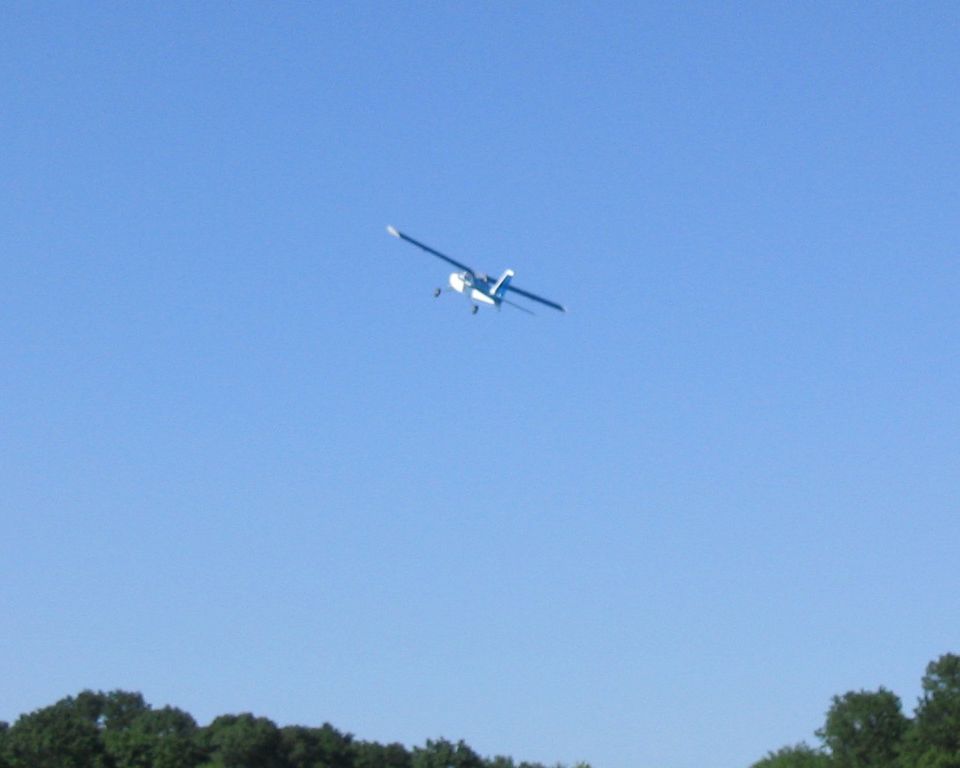
img_2655
June 4, 2005.
Objective: Test my FMA Direct Co-Pilot (2-axis IR flight stabalization system)
Conditions: Temperature in the middle 70’s, wind from the S and SW varying between 5 – 10+ mph. Rain had just moved through so conditions were improving, but the wind was changing to be from the SW and increasing thoughout the tests. We had a couple little sprinkles for a short time but they passed through quickly.
Results: Again, I absolutely love to fly this airplane. It is such a delight to fly. Please see my description of the FMA Direct Co-Pilot in the Self Stabalization section of the EGN-1 project pages.
I think my tests were reasonably successful. I’m happy enough with the co-pilot to move forward and start looking at getting my flight computer running.
Other: I just wanted to mention again that I always have a lot of fun flying this airplane. I was the only one at the field tonight so no pictures, but one flight I took it up to a fairly high altitude. The cloud ceilings were still pretty low as the weather was still moving out. I stayed under the clouds so I know I didn’t got *that* high. 🙂 For some reason my engine killed on my after a couple minutes of running full throttle (heat?). This left me dead stick, but up high. My neck was getting sore from looking up so I layed down in the middle of the runway and just steered around above me as this stupid thing kept floating and floating seemingly forever … I probably glided for 10 minutes??? When I got lower I stood up, set up my approach, did a little slipping on final and touched down right at my feet. Very cool.
Another thing that is fun to do is overflair on landing and drag the tail wheel first for several feet before the mains touch down. I also am enjoying 1/3rd to 1/2 throttle take offs. At full throttle the plane leaps into the air quickly, but at reduced throttle take offs are much more “scale” like.
May 19, 2005.
Objective: Test and tune and continue to break in the engine.
Conditions: Temperature in the middle 60’s, wind from the from the north east at about 10mph. Overcast low clouds that looked a bit threatening, but we stayed dry.
Results: A bit mixed. I’m still not sure I have the engine exactly where I want it to be, but it’s *much* improved. I had the opportunity to execute a dead stick landing from high altitude. By slipping on the downwind and final legs of the approach I was able to plunk her down exactly where I wanted her … cool. Overall I had a fun and successful day with several flights, a “successful” dead stick landing and an engine that is getting closer to where I want it to be. I’m getting more comfortable flying this airplane and it’s becoming more intuitive to do slips on approach without wobbling all over the sky.
May 13, 2005.
Maiden flight! This afternoon I maidened my Kadet Senior ARF. I just can’t get over what an incredibly sweet flying airplane it is. I’m suddenly a huge SIG fan. 🙂
Objective: First flight. Get airborn, trim the aircraft, get a feel for the flight characteristics, and practice landings. Shake out any bugs before they get big enough to bite me.
Conditions: Temperature in the upper 50’s (F). 5-10 mph cross wind from the east.
Results: I was the only one at the field so I don’t have any new pictures, but the Kadet flies *really* well.
Engine: I found a good ebay deal on a brand new ASP 61 FS (which is the same as Magnum 61 FS.) I am just breaking in a brand new engine, so starting out it ran pretty tight and was very sensitive to the needle valve setting. As the engine ran a bit, it became much smoother at low and mid rpm ranges. At one point the engine died on the “go” part of a touch and go. I traced this down to a failing glow plug, replaced it, and was back in business.
Taxiing: I converted the Kadet to a tail dragger arrangement. I was a little unsure of the turning radius because I didn’t have much movement on the tailwheel. I found that I had just enough to do a 180 in the width of my club runway. The Kadet is very light, and the ASP 61 FS engine pulls it right along even at idle, so on a smooth surface it is always moving. With 1/2 – 3/4 throttle, the Kadet happily taxis through medium height grass.
Takeoff: My club runway is small enough so you don’t have a lot of space to monkey around. You pretty much have to gun-n-go and sort everything out in the air. This was no problem, the Kadet tail dragger tracks straight, has no ill tendencies, and will get airborn in just a few feet if you gun the throttle. Once in the air I needed a few clicks here and there of trim, but nothing too much. For future flights I want to play around with mid-throttle settings for takeoffs to get a longer take off run and more scale-like behavior. Once the tail comes up though you are basically above flying speed.
Climbout: At full throttle, the 61 FS will pull the Kadet up at a very steep climb angle, but not quite vertically. This could let you get airborn out of some pretty tight spaces … if you were so inclined. If you had a knowledgable pitcher, I suspect you could hand launch the kadet pretty easily.
Flying: The Kadet Senior is slow. Even at full throttle it’s slow. But it’s big and elegant. It will do loops and nice axial rolls easily and gracefully. I didn’t push things like spins or more violent maneuvers, maybe later. It will tool along at just a few clicks above idle throttle. I did try some vertical climbs and found I didn’t have enough power to go unlimited vertical. That’s probably a good thing. I suspect an overpowered Kadet could start fluttering and shedding important bits if you flew it too fast. But what a joy. If you are looking for something that is more towards the relaxing end of the spectrum (but still highly manueverable and controllable) and less on the white-knuckle end of the spectrum, this is the bird for you.
Approaches: One of the first things I do on a maiden flight is throttle back and start getting a feel for the approach characteristics of the airplane. In this case, the Kadet likes to float and float and float and float … and then float some more. On my first attempt I started my down wind at about 50′ AGL. I turned base and decended to about 25′ AGL … and I was a long way out when I turned final. I figured I was going to have to run a lot of throttle to make it to the touch down point, but no … it kept floating and floating, and floated right past me at eye level. I kicked in the throttle, executed a missed approach, then lowered the idle trim a bit and tried again …
I found that I could cross control the rudder and aileron, especially on my base leg to bleed off altitude. I’m not real smooth with this, but it works well and looks really good when done right. I need to practice this so I can get comfortable with a slip on final and have better control over the decent angle.
We had a bit of a cross wind this afternoon, but that was actually kind of fun because the Kadet lands so slowly, you really have to crab it a lot to hold the runway centerline in even a moderate cross wind.
Landing: All I can say is wow. This plane has the ability to land ever so gently. It floats outside ground effect, but get that big wing down close to the ground and you begin to worry about the buttered toast strapped to the back of a cat syndrome … is there some ill understood force that is keeping this thing perpetually airborn? After a few landings I begin to get better control of my touch down spot, and I could ease it in with out even flexing the soft gear. On my last landing of the day, I touched down on the left main (I could hear the wheel start to roll) it rolled a couple feet on one wheel, then lowered the right main (and could hear it beginning to roll) and rolled out the rest of the way dropping down below flight speed and finally slowing to a stop. If I hadn’t heard the wheels rolling I wouldn’t have know for sure if I was on the ground or not. This plane seems to give you enough control and moves slow enough so you can do those sorts of things with relative ease.
I had no tracking or stability problems with the tail dragger configuration in any phase of taxiing, takeoff or landing. The length and position of the gear seemed like it came out just about perfect for beautiful 3 point landings. I may want to beef up the gear at some point since it does flex a bit even when sitting still, but for now, you can land with so little additional load on the gear, it’s not a problem. If I start adding a camera, more fuel, or other payload options, I may need a bit stronger gear.
Summary: I am just really really really impressed with what a fun relaxing airplane this is to fly. I felt like I needed/wanted to use the rudder *much* more than your typical sport plane. I had to laugh at how slow it will fly. I was puttering around at just a couple clicks above idle throttle and the engine sounded like it wanted to quit at any time it was running so slow … landings are a dream. The gentleness of the landings are almost an out of body experience.
In terms of the objectives for the maiden flight, I was highly successful on all counts and was thoroughly impressed with the flight characteristics of this aircraft!
I hope to add a camera and do some aerial photography with this platform, so I’m very happy about how slow it will fly, and how much payload it should be able to easily carry.